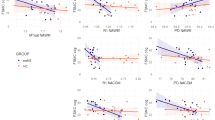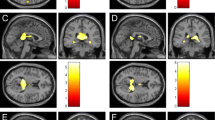Abstract
Introduction
Fatigue (F) is a common, inexplicable, and disabling symptom in multiple sclerosis (MS) patients. The purpose of this study was to evaluate a possible correlation between fatigue and morpho-volumetric features and site of dilated perivascular spaces (dPS), visible on 3T magnetic resonance (MR) in fatigued multiple sclerosis patients (FMS).
Methods
We studied 82 relapsing remitting (RR) FMS patients and 43 HC, matched for age, sex, and education. F was assessed by the Fatigue Severity Scale (FSS). To evaluate a possible correlation between degree of F and characteristics of dPS, patients were divided in two groups: more (mFMS) (FSS ≥ 5; n = 30) and less fatigued (lFMS) (FSS ≥ 4; n = 52), compared to a matched healthy control (HC) subject group. The MR study was performed with 3T scanner by SpinEcho T1, Fast-SpinEcho DP-T2, FLAIR, and 3D FSPGR T1 sequences. dPS volumes were measured with Medical Image Processing Analysis and Visualization (MIPAV); Global Cerebral Atrophy (GCA), expressed as Brain Parenchymal Fraction (BPF), was assessed by FSL SIENAX.
Results
The t test showed significantly increased dPS number (p = 0.021) in FMS patients (mFMS p = 0.0024 and lFMS p = 0.033) compared to HC. Pearson correlation revealed a significant correlation between dPS number and FSS (r = 0.208 p = 0.051). Furthermore, the chi-squared test confirms the intragroup (HC, mFMS, lFMS) differences about dPS location (p = 0.01) and size (p = 0.0001).
Conclusion
Our study confirms that PS in MS patients presents with different volumetric and site characteristics as compared to HC; moreover, F severity significantly correlates with dPS number, site, and size.




Similar content being viewed by others
References
Induruwa I, Constantinescu CS, Gran B (2012) Fatigue in multiple sclerosis—a brief review. J Neurol Sci 323:9–15
Niepel G, Tench CR, Morgan PS, Evangelou N, Auer DP, Constantinescu CS (2006) Deep gray matter and fatigue in MS. A T1 relaxation time study. J Neurol 253:896–902
Leocani L, Colombo B, Comi G (2008) Physiopathology of fatigue in multiple sclerosis. Neurol Sci 29(Suppl 2):S241–S243
Kos D, Kerckhofs E, Nagels G, D’hooghe MB, Ilsbroukx S (2008) Origin of fatigue in multiple sclerosis: review of the literature. Neurorehabil Neural Repair 22(1):91–100
Bakshi R, Miletich RS, Henschel K, Shaikh ZA, Janardhan V et al (1999) Fatigue in multiple sclerosis: cross-sectional correlation with brain MRI findings in 71 patients. Neurology 53(5):1151–1153
Colombo B, Martinelli BF, Rossi P, Rovaris M, Maderna L, Filippi M, Comi G (2000) MRI and motor evoked potential findings in nondisabled multiple sclerosis patients with and without symptoms of fatigue. J Neurol 247:506–509
Van der Werf SP, Jongen PJ, Hommes OR, Bleijenberg G, Barkhof F, Hommes OR, Bleijenberg G (1998) Fatigue in multiple sclerosis: interrelations between fatigue complaints, cerebral MRI abnormalities and neurological disability. J Neurol Sci 160:164–170
Marrie RA, Fisher E, Miller DM, Lee JC, Rudick RA (2005) Association of fatigue and brain atrophy in multiple sclerosis. J Neurol Sci 228:161–166
Tedeschi G, Dinacci D, Lavorgna L, Prinster A, Savettieri G, Quattrone A et al (2007) Correlation between fatigue and brain atrophy and lesion load in multiple sclerosis patients independent of disability. J Neurol Sci 263:15–19
Heesen C, Nawrath L, Reich C, Bauer N, Schulz KH, Gold SM (2006) Fatigue in multiple sclerosis: an example of cytokine mediated sickness behaviour? J Neurol Neurosurg Psychiatry 77:34–39
Tartaglia MC, Narayanan S, Francis SJ, Carlos Santos A, De Stefano N, Lapierre Y, Arnold DL (2004) The relationship between diffuse axonal damage and fatigue in multiple sclerosis. Arch Neurol 61:201–207
Krupp LB, Christodoulou C (2001) Fatigue in multiple sclerosis. Curr Neurol Neurosci Rep 1:294–298
Staines DR, Brenu EW, Marshall-Gradisnik S (2008) Review article postulated role of vasoactive neuropeptide-related immunopathology of the blood brain barrier and Virchow-Robin Spaces in the aetiology of neurological-related conditions. Mediat Inflamm 2008:1–5, 792428
Staines DR (2008) Are multiple sclerosis and amyotrophic lateral sclerosis autoimmune disorders of endogenous vasoactive neuropeptides? Med Hypotheses 70:413–418
Conforti R, Cirillo M, Saturnino PP, Gallo A, Sacco R, Negro A et al (2013) Dilated Virchow-Robin spaces and multiple sclerosis: 3T magnetic resonance study. Radiol Med. doi:10.1007/s11547-013-0357-9
Algin O, Conforti R, Saturnino PP, Ozmen E, Cirillo M et al (2012) Giant dilatations of Virchow–Robin spaces in the midbrain: MRI aspects and review of the literature. Neuroradiol J 25:415–422
MacLullich AMJ, Wardlaw JM, Ferguson KJ, Starr JM, Seckl JR, Deary IJ (2004) Enlarged perivascular spaces are associated with cognitive function in healthy elderly men. J Neurol Neurosurg Psychiatry 75:1519–1523
Polman CH, Reingold SC, Banwell B, Clanet M, Cohen JA, Filippi M et al (2011) Diagnostic criteria for multiple sclerosis: 2010 revisions to the McDonald criteria. Ann Neurol 69(2):292–302
Millis RJ, Young CA, Smith ETS (2006) 3D MRI in multiple sclerosis: a study of three sequences at 3T. Br J Radiol 80:307–320
Wuerfel J, Haertle M, Waiczies H et al (2008) Perivascular spaces—MRI marker of inflammatory activity in the brain? Brain 131:2332–2340
Kwee RM, Kwee TC (2007) Virchow–Robin spaces at MR imaging. Radiographics 27:1071–1086
Etemadifar M, Hekmatnia A, Tayari N et al (2011) Features of Virchow–Robin spaces in newly diagnosed multiple sclerosis patients. Eur J Radiol 80:e104–e108
Codella M, Rocca MA, Colombo B, Martinelli-Boneschi F, Comi G, Filippi M (2002) Cerebral grey matter pathology and fatigue in patients with multiple sclerosis: a preliminary study. J Neurol Sci 194:71–74
Neema M, Stankiewicz J, Arora A, Guss ZD, Bakshi R (2007) MRI in multiple sclerosis: what’s inside the toolbox? Neurotherapeutics 4(4):602–617
Filippi M, Rocca MA, Colombo B, Falini A, Codella M, Scotti G et al (2002) Functional magnetic resonance imaging correlates of fatigue in multiple sclerosis. NeuroImage 15:559–567
Filippi M, Rocca MA (2005) MRI evidence for multiple sclerosis as a diffuse disease of the central nervous system. J Neurol 252(Suppl 5):V/16–V/24. doi:10.1007/s00415-005-5004-5
Heier LA, Bauer CJ, Schwartz L et al (1989) Large Virchow–Robin spaces—MR clinical correlation. Am J Neuroradiol 10:929–936
Udaka F, Sawada H, Kameyama M (2002) White matter lesions and dementia—MRI-pathological correlation. Ann N Y Acad Sci 977:411–415
Gay FW (2006) Early cellular events in multiple sclerosis intimations of an extrinsic myelinolytic antigen. Clin Neurol Neurosurg 108:234–240
van Horssen J, Bo L, Vos CM, Virtanen I, de Vries HE (2005) Basement membrane proteins in multiple sclerosis-associated inflammatory cuffs: potential role influx and transport of leukocytes. J Neuropathol Exp Neurol 64:722–729
Author information
Authors and Affiliations
Corresponding author
Ethics declarations
We declare that this manuscript does not contain clinical studies or patient data.
Conflict of interest
We declare that we have no conflict of interest.
Rights and permissions
About this article
Cite this article
Conforti, R., Cirillo, M., Sardaro, A. et al. Dilated perivascular spaces and fatigue: is there a link? Magnetic resonance retrospective 3Tesla study. Neuroradiology 58, 859–866 (2016). https://doi.org/10.1007/s00234-016-1711-0
Received:
Accepted:
Published:
Issue Date:
DOI: https://doi.org/10.1007/s00234-016-1711-0




